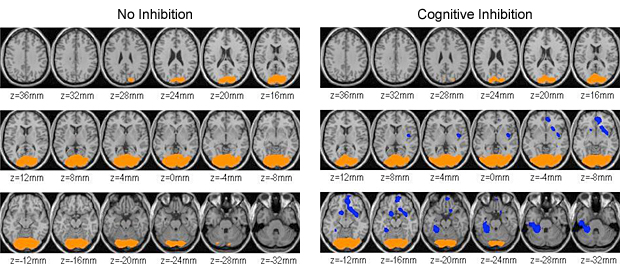Brain Scan Study Shows Cocaine Abusers Can Control Cravings
New treatments aimed at strengthening inhibitory control could help prevent relapse
November 30, 2009
UPTON, NY — When asked to inhibit their response to a “cocaine-cues” video, active cocaine abusers were, on average, able to suppress activity in brain regions linked to drug craving, according to a new study at the U.S. Department of Energy’s Brookhaven National Laboratory. The results, to be published in an upcoming issue of NeuroImage, suggest that clinical interventions designed to strengthen these inhibitory responses could help cocaine abusers stop using drugs and avoid relapse.

Gene-Jack Wang and Nora Volkow
“Exposure to drugs or stimuli associated with using drugs is one of the most common factors leading to relapse in drug-addicted individuals,” said Nora Volkow, Director of the National Institute on Drug Abuse and lead author on the paper.
“We know from previous studies that drug cues can trigger dramatic changes in the brain that are linked to a strong craving response,” added co-author Gene-Jack Wang, Chair of Brookhaven’s medical department. “This study provides the first evidence that cocaine abusers retain some ability to cognitively inhibit their craving responses to drug-related cues.”
Added Volkow, “Our findings provide enormous hope because they imply that cognitive interventions might be developed to maximize cocaine abusers’ success in blocking the drug-craving response to help them avoid relapse.”
The scientists used a brain-scanning technique called positron emission tomography (PET) and a radioactively “tagged” form of glucose — the brain’s main fuel — to measure brain activity in 24 active cocaine abusers during three different conditions: 1) while subjects simply lay in the scanner with eyes open; 2) while subjects watched a “cocaine-cues” video with scenes simulating the purchase, preparation, and smoking of crack cocaine; and 3) while subjects watched the video but were told to try to inhibit their craving response. Scans were performed in random order and on separate days.
 enlarge
enlarge
Left: When active cocaine users watched a video showing people taking cocaine and other cocaine-associated cues, the areas of the brain shown in orange "lit" up, or became more activated an indication that they were craving the drug. Right: When the subjects were told to inhibit their craving while watching the cocaine-cues video (cognitive inhibition), activity in the brain regions shown in blue decreased. The researchers say this deactivation is a way for the brain to "tune out" the cocaine cues and is an indication of their ability to inhibit craving.
In each scan, the PET camera tracked the radioactive signal from the tagged glucose as it was taken up by various regions of the brain. A stronger signal indicates higher metabolic activity in a particular brain region where more glucose is being used. This technique allows scientists to accurately monitor which brain regions are most active and how that activity changes with time or in response to different situations.
The scientists also monitored the research subjects’ heart rate and blood pressure and asked them to describe their level of craving during the scans.Compared with the baseline condition, the cocaine-cues video triggered increases in brain activity in several brain regions associated with drug craving, as well as increases in research subjects’ self-reports of craving.
When the research subjects were asked to inhibit their response to the video, and those scans were compared with the no-inhibition condition, metabolic activity decreased dramatically in brain regions involved in experiencing and anticipating rewards, and in a part of the brain that plays a role in assigning value, or salience, to different stimuli. During inhibition, research subjects also reported lower levels of craving compared with the no-inhibition video condition.
The researchers say the findings have significant clinical implications:
“Many current drug treatment programs help addicted individuals predict when and where they might be exposed to drug cues so that they can avoid such situations,” Volkow said. “While this is a very useful strategy, in real-word situations, cues may come up in unexpected ways. Our findings suggest that a clinical strategy that trains cocaine abusers to exert greater cognitive control could help them selectively inhibit the craving response whenever and wherever drug cues are encountered — whether expectedly or unexpectedly.”
Because inhibitory control is crucial for regulating emotions and desires, the findings from this study could have implications for other disorders involving loss of behavioral control, such as gambling and obesity.
This study was supported by the intramural program from the National Institutes of Health Intramural Research Program at the National Institute on Alcohol Abuse and Alcoholism. Brookhaven Lab’s infrastructure for PET imaging and radiotracer development also receive support from the DOE Office of Science.
2009-11026 | INT/EXT | Newsroom









